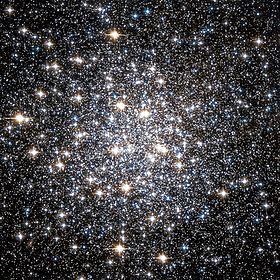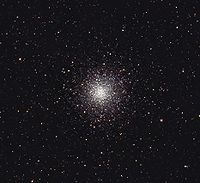- Messier 10
-
Messier 10 
Messier 10 by Hubble Space Telescope; 3.5′ view
Credit: NASA/STScI/WikiSkyObservation data (J2000 epoch) Class VII Constellation Ophiuchus Right ascension 16h 57m 08.99s[1] Declination -04° 05′ 57.6″[1] Distance 14.3 kly (4.4 kpc) Apparent magnitude (V) 6.4[1] Apparent dimensions (V) 20′.0 Physical characteristics Mass 2.25 × 105[2] M☉ Radius 41.6 ly [3] Other designations NGC 6254[1] See also: Globular cluster, List of globular clusters Messier 10 or M10 (also designated NGC 6254) is a globular cluster in the constellation of Ophiuchus.
The object was discovered by Charles Messier on May 29, 1764, who cataloged it as number 10 in his list. He described it as a "nebula without stars", but later study revealed it as a globular cluster of thousands of stars.
M10 has an apparent diameter of some 20 arcminutes, about two-thirds of the apparent diameter of the Moon. Viewed through medium-sized telescopes it appears about half that size (8' to 9'), as its bright core is only 35 light-years across. M10 has a spatial diameter of 83 light-years and is estimated to be 14,300 light-years away from Earth. Four variable stars have been discovered in this cluster.
This cluster completes an orbit through the Milky Way galaxy about every 140 million years, during which it crosses the plane of the galactic disk every 53 million years. This rosette orbit has an eccentricity of 0.21.[2]
References
- ^ a b c d "M 10 -- Globular Cluster". SIMBAD Astronomical Database. Centre de Données astronomiques de Strasbourg. http://simbad.u-strasbg.fr/simbad/sim-basic?Ident=M+10. Retrieved 2010-03-19.
- ^ a b Gnedin, Oleg Y.; Lee, Hyung Mok; Ostriker, Jeremiah P. (1999). "Effects of Tidal Shocks on the Evolution of Globular Clusters". Astrophysical Journal 522 (2): 935–949. arXiv:astro-ph/9806245. Bibcode 1999ApJ...522..935G. doi:10.1086/307659.
- ^ distance × sin( diameter_angle / 2 ) = 41.6 ly. radius
External links
- Messier 10, SEDS Messier pages
- Messier 10, Galactic Globular Clusters Database page
- Messier 10 on WikiSky: DSS2, SDSS, GALEX, IRAS, Hydrogen α, X-Ray, Astrophoto, Sky Map, Articles and images
Coordinates:
 16h 57m 08.99s, −04° 05′ 57.6″
16h 57m 08.99s, −04° 05′ 57.6″Messier objects List M1 · M2 · M3 · M4 · M5 · M6 · M7 · M8 · M9 · M10 · M11 · M12 · M13 · M14 · M15 · M16 · M17 · M18 · M19 · M20 · M21 · M22 · M23 · M24 · M25 · M26 · M27 · M28 · M29 · M30 · M31 · M32 · M33 · M34 · M35 · M36 · M37 · M38 · M39 · M40 · M41 · M42 · M43 · M44 · M45 · M46 · M47 · M48 · M49 · M50 · M51 · M52 · M53 · M54 · M55 · M56 · M57 · M58 · M59 · M60 · M61 · M62 · M63 · M64 · M65 · M66 · M67 · M68 · M69 · M70 · M71 · M72 · M73 · M74 · M75 · M76 · M77 · M78 · M79 · M80 · M81 · M82 · M83 · M84 · M85 · M86 · M87 · M88 · M89 · M90 · M91 · M92 · M93 · M94 · M95 · M96 · M97 · M98 · M99 · M100 · M101 · M102 · M103 · M104 · M105 · M106 · M107 · M108 · M109 · M110See also  Book:Messier objects ·
Book:Messier objects ·  Category:Messier objects
Category:Messier objects  Portal:AstronomyCategories:
Portal:AstronomyCategories:- Globular clusters
- Ophiuchus constellation
- Messier objects
- NGC objects
- Star cluster stubs
Wikimedia Foundation. 2010.

